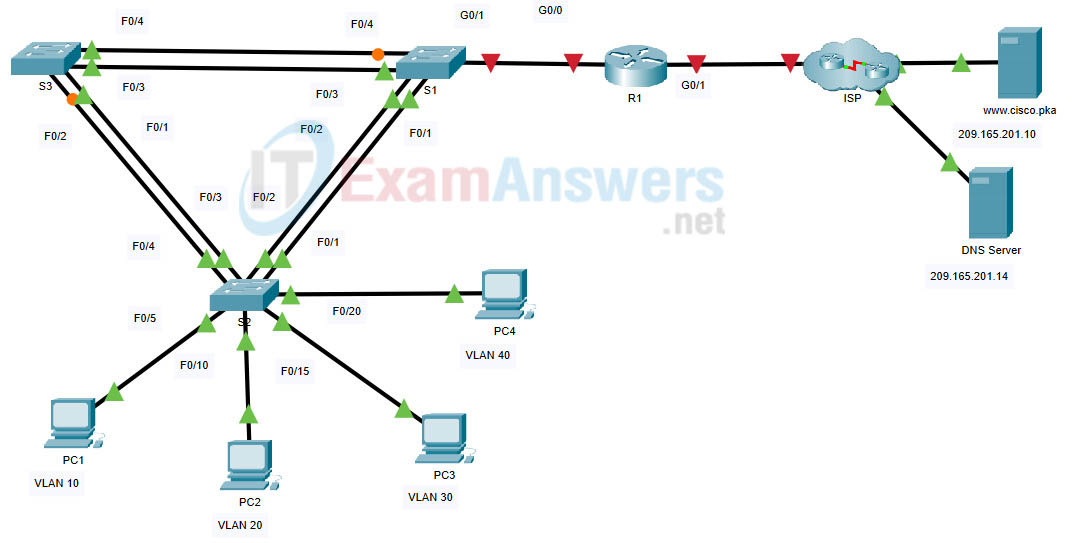1.2.1 Packet Tracer – DHCP for IPv4 and Routing Between VLANs (Answers)
Topology

1.2.1 Packet Tracer – DHCP for IPv4 and Routing Between VLANs
Addressing Table
| Device | Interface | IP Address | Subnet Mask | Default Gateway |
|---|---|---|---|---|
| R1 | G0/0.10 | 172.31.10.1 | 255.255.255.224 | N/A |
| G0/0.20 | 172.31.20.1 | 255.255.255.240 | ||
| G0/0.30 | 172.31.30.1 | 255.255.255.128 | ||
| G0/0.40 | 172.31.40.1 | 255.255.255.192 | ||
| G0/1 | DHCP Assigned | DHCP Assigned | ||
| PC1 | NIC | DHCP Assigned | DHCP Assigned | DHCP Assigned |
| PC2 | NIC | DHCP Assigned | DHCP Assigned | DHCP Assigned |
| PC3 | NIC | DHCP Assigned | DHCP Assigned | DHCP Assigned |
| PC4 | NIC | DHCP Assigned | DHCP Assigned | DHCP Assigned |
VLAN Port Assignments and DHCP Information
| Ports | VLAN Number – Name | DHCP Pool Name | Network |
|---|---|---|---|
| F0/5 – F0/9 | VLAN 10 – Sales | VLAN_10 | 172.31.10.0/27 |
| F0/10 – F0/14 | VLAN 20 – Production | VLAN_20 | 172.31.20.0/28 |
| F0/15 – F0/19 | VLAN 30 – Marketing | VLAN_30 | 172.31.30.0/25 |
| F0/20 – F0/24 | VLAN 40 – HR | VLAN_40 | 172.31.40.0/26 |
Scenario
In this activity, you will configure VLANs, trunks, DHCP Server pools, and configure a router as a DHCP client.
Requirements
Using the information in the tables above, implement the following requirements:
• Configure VLANs and trunking.
- Create VLANs on S2 and assign VLANs to appropriate ports. Names are case-sensitive
- Configure S2 ports for static trunking.
- Configure all non-trunk ports on S2 as static access ports.
• Configure R1 to route between VLANs. Subinterface numbers should match the VLAN number.
• Configure R1 to act as a DHCP server for the VLANs attached to S2.
- Create a DHCP pool for each VLAN as shown in the VLAN Port Assignments and DHCP Information table. Names are case-sensitive.
- Assign the appropriate addresses to each pool.
- Configure DHCP to provide the default gateway address
- Configure the DNS server address of 209.165.201.14 for each pool.
- Prevent the first 10 addresses from each pool from being distributed to end devices.
• Configure R1 as a DHCP client so that it receives an IP address from the ISP network.
• Verify that each PC has an address assigned from the correct DHCP pool.
Note: DHCP address assignments may take some time. Click Fast Forward Time to speed up the process.
• Verify all devices can now ping each other and www.cisco.pka.
Device Scripts
Router R1
enable config t ip dhcp excluded-address 172.31.10.1 172.31.10.10 ip dhcp excluded-address 172.31.20.1 172.31.20.10 ip dhcp excluded-address 172.31.30.1 172.31.30.10 ip dhcp excluded-address 172.31.40.1 172.31.40.10 ip dhcp pool VLAN_10 network 172.31.10.0 255.255.255.224 default-router 172.31.10.1 dns-server 209.165.201.14 ip dhcp pool VLAN_20 network 172.31.20.0 255.255.255.240 default-router 172.31.20.1 dns-server 209.165.201.14 ip dhcp pool VLAN_30 network 172.31.30.0 255.255.255.128 default-router 172.31.30.1 dns-server 209.165.201.14 ip dhcp pool VLAN_40 network 172.31.40.0 255.255.255.192 default-router 172.31.40.1 dns-server 209.165.201.14 interface GigabitEthernet0/0 no shutdown interface GigabitEthernet0/0.10 encapsulation dot1Q 10 ip address 172.31.10.1 255.255.255.224 interface GigabitEthernet0/0.20 encapsulation dot1Q 20 ip address 172.31.20.1 255.255.255.240 interface GigabitEthernet0/0.30 encapsulation dot1Q 30 ip address 172.31.30.1 255.255.255.128 interface GigabitEthernet0/0.40 encapsulation dot1Q 40 ip address 172.31.40.1 255.255.255.192 interface GigabitEthernet0/1 ip address dhcp no shutdown end
Switch S2
enable config interface range f0/1 - 4 switchport mode trunk vlan 10 name Sales vlan 20 name Production vlan 30 name Marketing vlan 40 name HR interface range f0/5-24 switchport mode access interface range f0/5-9 switchport access vlan 10 interface range f0/10-14 switchport access vlan 20 interface range f0/15-19 switchport access vlan 30 interface range f0/20-24 switchport access vlan 40 end
